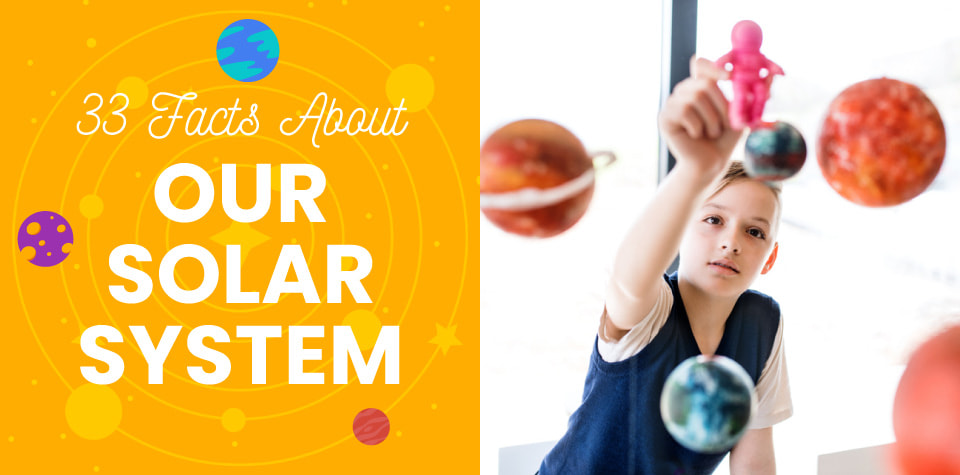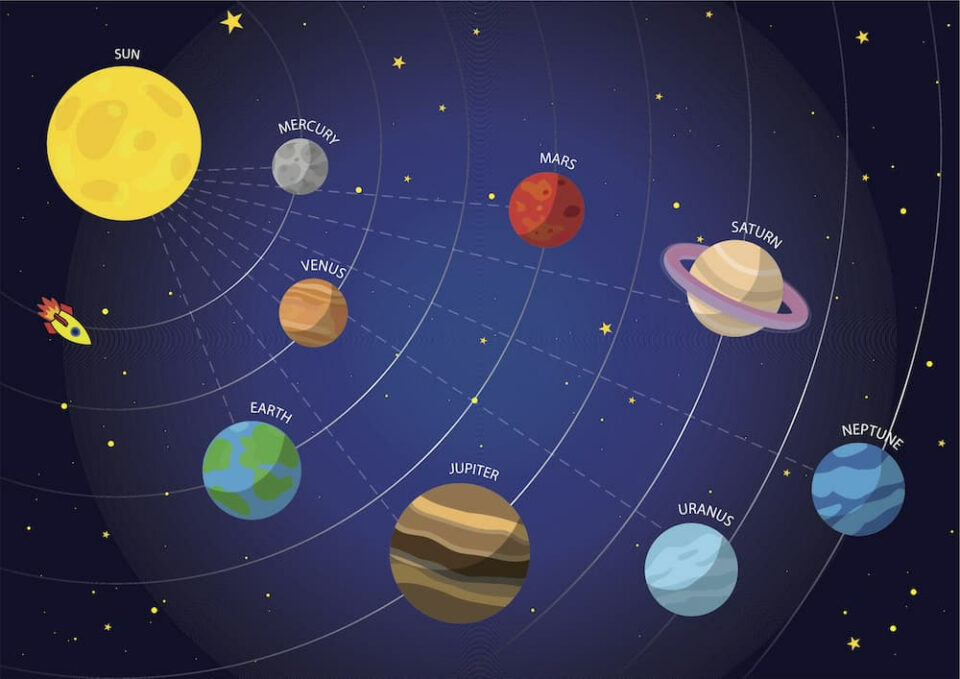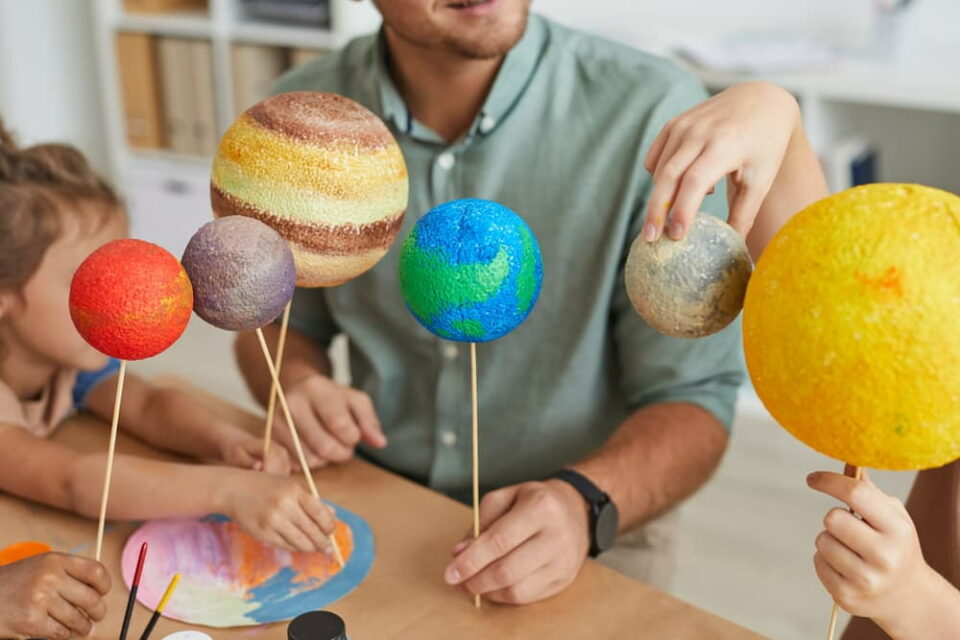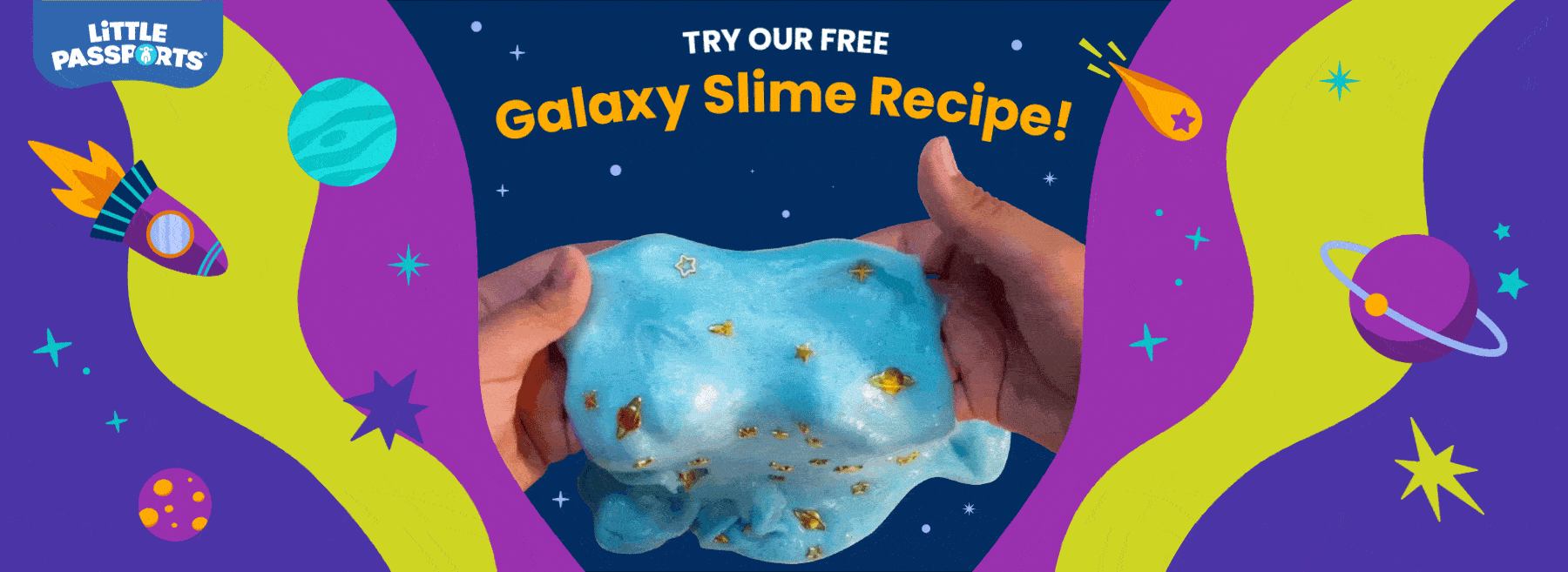
Soar Beyond the Stars! 33 Facts about Our Solar System
What’s one of the first things you do when you move to a new home? You get to know the neighbors. And our cosmic neighborhood, the solar system, is full of wonders.
Get ready to launch your discoverer’s space explorations beyond Earth with these thrilling facts about the planets and our solar system.
Get to Know Earth’s Neighborhood
Earth is part of a group of eight planets that orbit the same star, the Sun. Mercury is closest to the Sun, followed by Venus, Earth, Mars, Jupiter, Saturn, Uranus, and Neptune. Scientists refer to planetary groupings like ours as a solar system. As big as our solar system is, it’s only a tiny part of an enormous galaxy called the Milky Way, which contains billions of stars.
Here’s one way to picture it: If the distance from the Sun to the solar system’s edge were one hundred yards, the Sun would be about the size of a dime. If you placed that dime-sized Sun at the beginning of the hundred yards, Mercury would sit slightly more than one yard away. Venus would be another half-yard beyond Mercury, and Earth would sit at the two-yard mark. You’d find Mars at the three-yard mark, followed by Jupiter ten and a half yards away from the Sun. Saturn would be much farther down the field, approximately nineteen yards away. Uranus and Neptune would be even farther: thirty-eight yards and sixty yards out, respectively.
That’s a lot of space, but it’s not empty. You’ll find dozens of moons and millions of asteroids, comets, and meteors within this vast region. There are even a few dwarf planets, like Pluto, circling our star.
Here are some fascinating facts about each planet to kick off your child’s journey into the incredible world of space.
What’s a Planet?
The International Astronomical Union (IAU) determines the official definition of a planet, and they’ve refined it somewhat over the years as more information about the solar system comes to light. According to the IAU, to be considered a planet, a celestial body has to:
- Orbit around a star
- Have enough mass to maintain its round shape (hydrostatic equilibrium)
- Not share its orbital path with another planet
That final point is why scientists downgraded Pluto’s status in 2006. Pluto shares its orbital path with Neptune, categorizing it as a dwarf planet alongside Ceres, Haumea, Makemake, and Eris. Ceres can be found within the asteroid belt between Mars and Jupiter, while the rest reside in the Kuiper belt at the solar system’s edge.

There are two types of planets: terrestrial planets and gas giants. Terrestrial planets like Mercury, Venus, Earth, and Mars are found closer to the Sun and have a solid, rocky surface. Jupiter, Saturn, Uranus, and Neptune are gas giants. These are massive planets without a solid surface. They’re formed from a combination of hydrogen and helium, with some other trace gases thrown in.
Now that you know what our solar system’s planets have in common, let’s dive into some unique planet facts for kids who are eager to explore the universe, starting with these Mercury planet facts:
Mercury
- Mercury is the closest planet to the Sun. If you stood on Mercury’s surface, the Sun would appear three times larger than it does from Earth. Mercury is also the smallest planet in the solar system, roughly the same size as Earth’s Moon.
- Light from the Sun reaches Mercury in three minutes, compared to the eight minutes it takes to reach Earth.
- Mercury is tiny compared to other planets. It’s about as wide as the Atlantic Ocean, and if our world were hollow, you could stuff 18 Mercurys inside Earth.
- The planet takes its name from Roman mythology, in which Mercury was the god of commerce as well as the messenger of the gods.
Venus
- Fluffy sulfur clouds fill the sky on Venus, where the atmosphere is extremely thick and rich in carbon dioxide, a greenhouse gas that traps heat, making it the hottest planet in the solar system. The average temperature is approximately nine hundred degrees Fahrenheit!
- Venus is the planet in the solar system that comes the closest to matching Earth’s size and composition.
- Venus takes 225 Earth days to complete its orbit around the Sun, but it takes 243 Earth days to complete one rotation on its axis. That means on Venus, one day lasts longer than one year!
- Venus is named for the Roman goddess of beauty.
Earth
- The word Earth comes from the Germanic word for the ground, erde. Our planet has many names, including Gaia (Greek), Tellus (Latin), Jigu (Korean), and Dunia (Swahili).
- Earth is the largest terrestrial planet and the fifth-largest planet in the solar system. It’s the only planet in the solar system that currently supports life.
- Our planet’s axis tilts 23 degrees, which creates different seasons across the globe.
- A magnetic field surrounds Earth and protects us from solar radiation. Interactions between the magnetic field and radiation cause the shimmering aurora borealis, also called the northern lights, in the Northern Hemisphere, as well as the aurora australis, the southern lights, in the Southern Hemisphere.
Mars
- Mars has two moons, Phobos and Deimos. Astronomers believe that Phobos’s orbit is decaying and that it will crash into the planet within the next fifty million years, an impact that will create a ring around Mars similar to the rings around Saturn.
- Mars is a rocky planet where the surface showcases deep craters, valleys, and volcanoes. Astronomers believe its Olympus Mons volcano is the largest in the solar system, measuring two and a half times taller than Mount Everest.
- NASA has confirmed the presence of water on Mars. Its frigid climate keeps most of the water trapped as ice, but scientists have detected seasonal water flows in the Hale Crater. That’s not enough to hydrate the planet, however, and Mars’s surface remains, for the most part, arid.
- Mars is sometimes called the Red Planet, but its true name is that of the Roman god of war. Its moons bear the names of the god’s sons.
Jupiter
- Jupiter is the largest planet in our solar system—it would take 11 Earths to circle its equator—making it the third brightest light in the night sky. It’s so big that we can see it easily with the naked eye.
- The planet’s famous Great Red Spot is an enormous storm that’s been happening for more than three hundred years. It’s so big that two to three Earths could fit inside.
- Like Earth, Jupiter enjoys light shows in the form of auroras. These solar events are the brightest in the solar system.
- Astronomers believe that Europa, one of Jupiter’s 80 moons, has liquid water beneath its surface that could host extraterrestrial life.
- Jupiter is named for the head of the pantheon of Roman gods.
Saturn
- Saturn may have as many as 82 moons, the most of any planet in our solar system. The most famous of Saturn’s moons are Titan, the second-largest moon in our solar system, Enceladus, and Io. Saturn can’t support life, but it’s believed that both Enceladus and Titan might be able to.
- Saturn is best known for its stunning set of seven rings circling the planet. These rings contain ice and rock and stretch for more than 173,000 miles from the planet’s surface. They would fill the space between Earth and our Moon.
- Saturn is the least dense of all the planets in our solar system. It would float if you could place it in a pool of water big enough to fit it.
- Saturn takes its name from the Roman god of agriculture.
Uranus
- Uranus’s axis is more horizontal than vertical, making it look like the planet is rotating upward instead of from side to side. It has the second-longest orbit of any planet, taking about 84 Earth years to complete its trip around the Sun.
- Uranus is another gas giant made up of helium, hydrogen, and methane, which combine to give the planet its beautiful sea blue color.
- Twenty-seven moons orbit the planet Uranus. Of that number, twenty-five take their names from Shakespearean characters, including Titania, Oberon, and Puck from A Midsummer’s Night Dream, and Miranda and Ariel from The Tempest. Two moons, Belinda and Umbriel, take their names from the poems of Alexander Pope.
- Uranus is the Latinized version of the name Ouranos, the Greek sky god.
Neptune
- Neptune is a gas giant composed of many of the same gases as Uranus and is four times bigger than Earth.
- A ring system similar to Saturn’s circles Neptune, which also has at least 14 moons around it. Neptune’s biggest moon is called Triton.
- Cover your ears! Neptune’s winds race across the planet, reaching speeds of more than eleven hundred miles per hour. That’s seven times faster than a Category 5 hurricane and about four times faster than the speed of sound.
- Neptune shares its name with the Roman god of the sea.
Bonus Planet: Pluto
Pluto isn’t a planet, technically speaking, but it’s so fascinating that it deserves its own set of fun facts:
- Pluto is so small you could drive across it in about 24 hours.
- Water makes up about one-third of the planet. Its thin atmosphere of nitrogen, methane, and carbon monoxide gives it a hazy blueish tint.
- Charon is the largest of Pluto’s five moons.
- In 1930, eleven-year-old Venetia Burney from the United Kingdom named Pluto after the Roman god of the underworld, who was able to make himself invisible. Burney’s grandfather, a librarian at the University of Oxford, shared her idea with an astronomer colleague, who passed it along to astronomers in the United States. The name was well received because it contained the initials of the American astronomer who first predicted Pluto’s existence, Percival Lowell.

Numbers Tell a Story
Some young space enthusiasts want to keep things simple. They’re interested in the hard data. Satisfy their curiosity with planetary information they can use to calculate space flights or determine their age if they lived on another world. Your child can use facts and figures that captivate their imagination as a springboard to greater knowledge.
Solar System Planet Facts Table
| Mercury | Venus | Earth | Mars | |
| Average Distance: (from the Sun) | 35,983,605 mi (57,909,999 km) | 67,232,363 mi(108,200,000 km) | 92,957,130 mi(149,599,999 km) | 141,635,349 mi(227,939,999 km) |
| Average temp.: | 354°F (179°C) | 847°F (453°C) | 57°F (14°C) | -81°F (-63°C) |
| Day Length: | 59 Earth days | 243 Earth days | 23.9 hours | 24.6 Earth days |
| Year Length: | 87.97 Earth days | 225 Earth days | 365.25 days | 687 Earth days |
| Jupiter | Saturn | Uranus | Neptune | |
| Average Distance: (from the Sun) | 483,631,840 mi(778,329,999 km) | 885,205,400 mi(1,424,599,999 km) | 1,785,541,189 mi(2,873,549,999 km) | 2,796,791,736 mi(4,500,999,999 km) |
| Average temp.: | -238°F (-150°C) | -285°F (-176°C) | -353°F (-214°C) | -373°F (-225°C) |
| Day Length: | 9.93 Earth hours | 10.7 Earth hours | 17 Earth hours | 16 Earth hours |
| Year Length: | 11.86 Earth years | 29 Earth years | 84 Earth years | 165 Earth years |
The First Resident
Now that your child knows more about their celestial neighborhood, they’re probably wondering how long it’s been around. Don’t worry—NASA is on the case!
To determine the solar system’s age, NASA needed to discover the age of the Sun, the first heavenly body in the solar system to form. To do this, experts studied the oldest material they could find—Moon rocks brought back from the Apollo missions.
After conducting many tests, NASA scientists determined that the Sun formed approximately four and a half billion years ago. That’s seventeen times farther back than when the first dinosaurs existed on Earth!
The Big Picture
Space exploration is a never-ending source of wonder. Something always pops up to spark another investigation. And when you’re ready, you can move beyond the borders of our solar system and onto your adventurer’s next great discovery: our galaxy, the Milky Way.
Start your exciting journey into learning about galaxies with an evening of stargazing. If you look up at the night sky, you’ll see stripes of stars curving across the darkness. These are the arms of the Milky Way. Our galaxy has four primary arms and several smaller fragment arms that come together in the center to form a spiral shape.
The Milky Way contains dust, gas, and more than five hundred billion stars. Of those stars, more than three thousand have a planetary system of their own. Who knows, there might be life outside our little celestial neighborhood. Wouldn’t it be amazing to imagine welcoming humanity’s neighbors with your young space explorer?
Keep the exploration going by introducing your adventurer to other amazing facts about life in our universe. Start by discovering the life cycle of a star before exploring the coldest place in the universe. Then take a trip between the planets to investigate asteroids and how they form. In space, there’s always a new surprise to delight eager minds.
Is your child keen to blast off into space? Do they love making connections between science, technology, and themselves? If so, they’ll love our Science Expeditions subscription box. Each month brings new STEM-based experiments and activities to explore.

